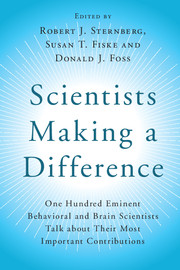 Scientists Making a Difference
Scientists Making a Difference Book contents
- Frontmatter
- Contents
- List of Contributors
- Foreword: Making a Creative Difference = Person × Environment
- Preface
- Part I Introduction
- Part II Biological Bases of Psychology: Genes, Brain, and Beyond
- Part III Cognition: Getting Information from the World and Dealing with It
- Part IV Development: How We Change Over Time
- Part V Motivation and Emotion: How We Feel and What We Do
- Part VI Social and Personality Processes: Who We Are and How We Interact
- Section A Social Cognition
- 74 Doing Good by Doing Good Research
- 75 The Incredible Little Shrinking Man in the Head
- 76 Ethnocentrism and the Optimal Distinctiveness Theory of Social Identity
- 77 Psychology of Gender: Nature and Nurture Working Together
- 78 How Warmth and Competence Inform Your Social Life
- 79 Two Routes to Persuasion
- Section B Personal Relationships
- Section C Group and Cultural Processes
- Part VII Clinical and Health Psychology: Making Lives Better
- Part VIII Conclusion
- Afterword: Doing Psychology 24×7 and Why It Matters
- Index
- References
74 - Doing Good by Doing Good Research
from Section A - Social Cognition
Published online by Cambridge University Press: 05 August 2016
- Frontmatter
- Contents
- List of Contributors
- Foreword: Making a Creative Difference = Person × Environment
- Preface
- Part I Introduction
- Part II Biological Bases of Psychology: Genes, Brain, and Beyond
- Part III Cognition: Getting Information from the World and Dealing with It
- Part IV Development: How We Change Over Time
- Part V Motivation and Emotion: How We Feel and What We Do
- Part VI Social and Personality Processes: Who We Are and How We Interact
- Section A Social Cognition
- 74 Doing Good by Doing Good Research
- 75 The Incredible Little Shrinking Man in the Head
- 76 Ethnocentrism and the Optimal Distinctiveness Theory of Social Identity
- 77 Psychology of Gender: Nature and Nurture Working Together
- 78 How Warmth and Competence Inform Your Social Life
- 79 Two Routes to Persuasion
- Section B Personal Relationships
- Section C Group and Cultural Processes
- Part VII Clinical and Health Psychology: Making Lives Better
- Part VIII Conclusion
- Afterword: Doing Psychology 24×7 and Why It Matters
- Index
- References
Summary
Throughout my life as a social psychologist, I have had two major goals: to design and conduct controlled experiments that shed light on how the human mind works, and to make discoveries that might be useful to people and perhaps even improve society. When I was about to enter graduate school, I had stars in my eyes so, understandably, the second goal was far more prominent than the first. However, by the time I earned my PhD, I had discovered that, as a scientist, there is no way to do good in the world without first being able to do good research.
My great good fortune was that I entered Stanford as a student the same year that Leon Festinger joined the faculty as a professor. At that time, Festinger was developing his theory of cognitive dissonance, which proposed that when a person simultaneously holds two contradictory cognitions, he or she experiences an unpleasant feeling of discomfort (dissonance). The person is motivated to reduce that dissonance by altering one or both cognitions, bringing them into consonance. This simple theory led us to make predictions about human behavior that were bold, exciting, and innovative.
For example, in the first experiment I ever designed, Jud Mills and I demonstrated that people who went through a severe initiation to join a group later liked the group better than those who went through a mild initiation. We didn't try to convince people that their group was terrific; rather, we set up a situation where they convinced themselves that the group was terrific. The cognition “I went through hell and high water to get into this group” was dissonant with the fact that the group was actually pretty boring. Therefore, following a severe initiation, they were inclined to convince themselves that those boring group members were quite charming. The people who didn't have to go through a severe initiation saw the group for what it was.
In another experiment, my students and I showed that children who were threatened with severe punishment if they played with a forbidden but attractive toy were eager to play with it anyway as soon as they had the chance.
- Type
- Chapter
- Information
- Scientists Making a DifferenceOne Hundred Eminent Behavioral and Brain Scientists Talk about Their Most Important Contributions, pp. 351 - 355Publisher: Cambridge University PressPrint publication year: 2016
